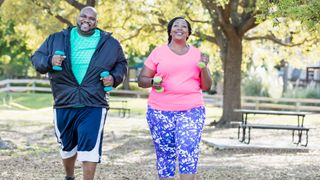How to go walking with weights to build muscle
Try working out outside and go walking with weights for some serious health benefits


Learning how to go walking with weights to build muscle is an attractive prospect, allowing you to skip the gym in favor of lacing up some of the best shoes for walking and heading out into the great outdoors. But is it possible?
Sadly, if hypertrophy is your goal, we have to say the gym wins hands down thanks to its wide selection of free weights and exercise machines custom-built to place stress on your muscles (a key component of muscle gain).
But that’s not to say that walking with weights doesn’t have a place in your fitness routine - it still offers plenty of health benefits. You’ll enjoy all the regular plus points of walking, such as improvements in mood, weight control, blood pressure levels, and more while increasing your overall effort and calorie burn by adding weights into the mix.
We’ve looked at the science and enlisted the help of exercise physiologist Bianca Grover to find out how to begin walking with weights, and explore the positive impacts it could have on your health.

What are the benefits of walking with weights?
There are plenty of mental and physical health benefits to walking with weights - whether they’re held in the hand or wrapped around the ankle. But, before we dive into these, it’s important to provide a quick overview of the plethora of positive effects of regular walking.
One study published in the Primary Care Companion to the Journal of Clinical Psychiatry states that brisk walking three days per week can bring about “improvements in weight control and reported increased fitness levels, exercise tolerance, reduced blood pressure levels, increased perceived energy levels, and increased upper body and hand grip strength levels”.
The same study also found that regular exercise, such as walking, can improve sleep and mood, reduce tiredness, provide stress relief, and increase mental alertness.
Get the Fit&Well Newsletter
Start your week with achievable workout ideas, health tips and wellbeing advice in your inbox.
So, by extension, walking with weights will provide these same benefits. But adding a little extra resistance to your stroll can also take your workout further by increasing your overall effort.
Research published in the Journal of Applied Physiology found that “intensity of effort and energy cost per minute and per mile were increased when weight was added during walking and was increased more with hand weights compared with ankle weights regardless of speed”.
Or, in other words, you will burn more calories walking with weights than walking without them. As a result, participants in the study used a similar amount of energy per mile when walking with weights at 4mph than if they were to jog the same distance at a moderate pace.

Bianca Grover is a certified exercise physiologist, medical exercise specialist and personal trainer. She holds several certifications and specializations from the American Council on Exercise (ACE), the American College of Sports Medicine (ACSM) and the American Heart Association. Her specialities include functional training, strength training, and orthopedic considerations.
Can walking with weights build muscle?
Despite the many health benefits that are on offer, walking with weights won't help you build a considerable amount of muscle, exercise physiologist Bianca Grover says. It will engage your leg muscles, including your quadriceps, hamstrings, glutes and calves, as well as your spine and core. However, walking with weights is unlikely to generate sufficient mechanical tension and metabolic stress for muscle growth in most people (as per the teachings of this systematic review from the International Journal of Environmental Research and Public Health).
The exception to prove this rule is walking with heavier weights over shorter distances, with exercises like the farmer’s carry or suitcase carry involving carrying a heavy dumbbell or kettlebell over a distance of around 20m.
Grover explains: “No, walking with weights cannot build muscle. True muscle growth is accomplished by putting muscles under load and stress, through a range of motion.
"If you are performing exercises such as farmer’s carries - which is essentially walking a shorter distance with a heavy amount of weight in each hand - you can improve grip strength and core stability. However, even this does not focus on muscle growth.”
If muscle growth is your goal, we recommend focusing on resistance training at the gym, or at home with a pair of the best adjustable dumbbells.

How to start walking with weights on ankles
Ankle weights are an obvious option for anyone looking to start walking with weights, but there are some things to consider before you get started.
“When it comes to walking with ankle weights, you'll need to make sure you have shoes that provide plenty of support,” Grover says. Fortunately, our guide to the best shoes for walking should be able to help on this front.
She also stresses that you should make sure you’re not using a weight that is so heavy it causes you to change the way you walk, or become uncomfortable.
“One of the key considerations when walking a longer distance or time with added load is the added stress it puts on joints, ligaments, and muscles. You will also want to make sure you maintain a normal walking form. If you begin to feel your posture or your stride become abnormal, you may want to take a break or lighten the weight. Nothing good comes from bad form.”
How to start walking with weights in hands
If you want to reap the benefits of using handheld weights while walking, Grover advises placing added emphasis on moving your arms as you stride. By increasing the amount of movement completed under the additional load of a small dumbbell or other handheld weight, you will up the intensity of your workout and burn more calories.
“Because you are holding weights, you may have the urge to hold them against your side, but this will not be as beneficial over the course of your routine,” Grover says Again, be conscious of any shoulder or elbow issues, as this extended period of stress can irritate them.”

Harry Bullmore is a Fitness Writer for Fit&Well and its sister site Coach, covering accessible home workouts, strength training session, and yoga routines. He joined the team from Hearst, where he reviewed products for Men's Health, Women's Health, and Runner's World. He is passionate about the physical and mental benefits of exercise, and splits his time between weightlifting, CrossFit, and gymnastics, which he does to build strength, boost his wellbeing, and have fun.
Harry is a NCTJ-qualified journalist, and has written for Vice, Learning Disability Today, and The Argus, where he was a crime, politics, and sports reporter for several UK regional and national newspapers.